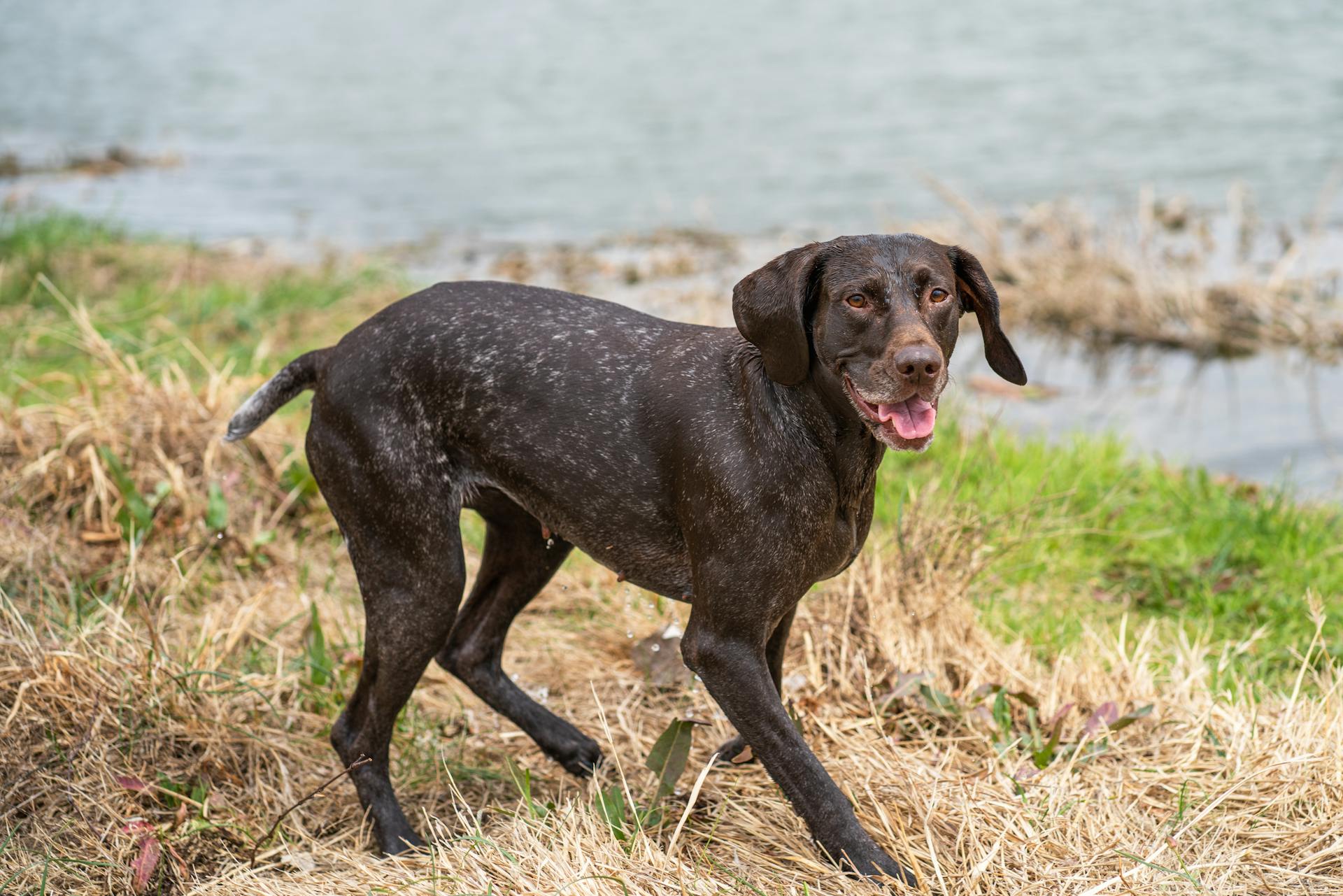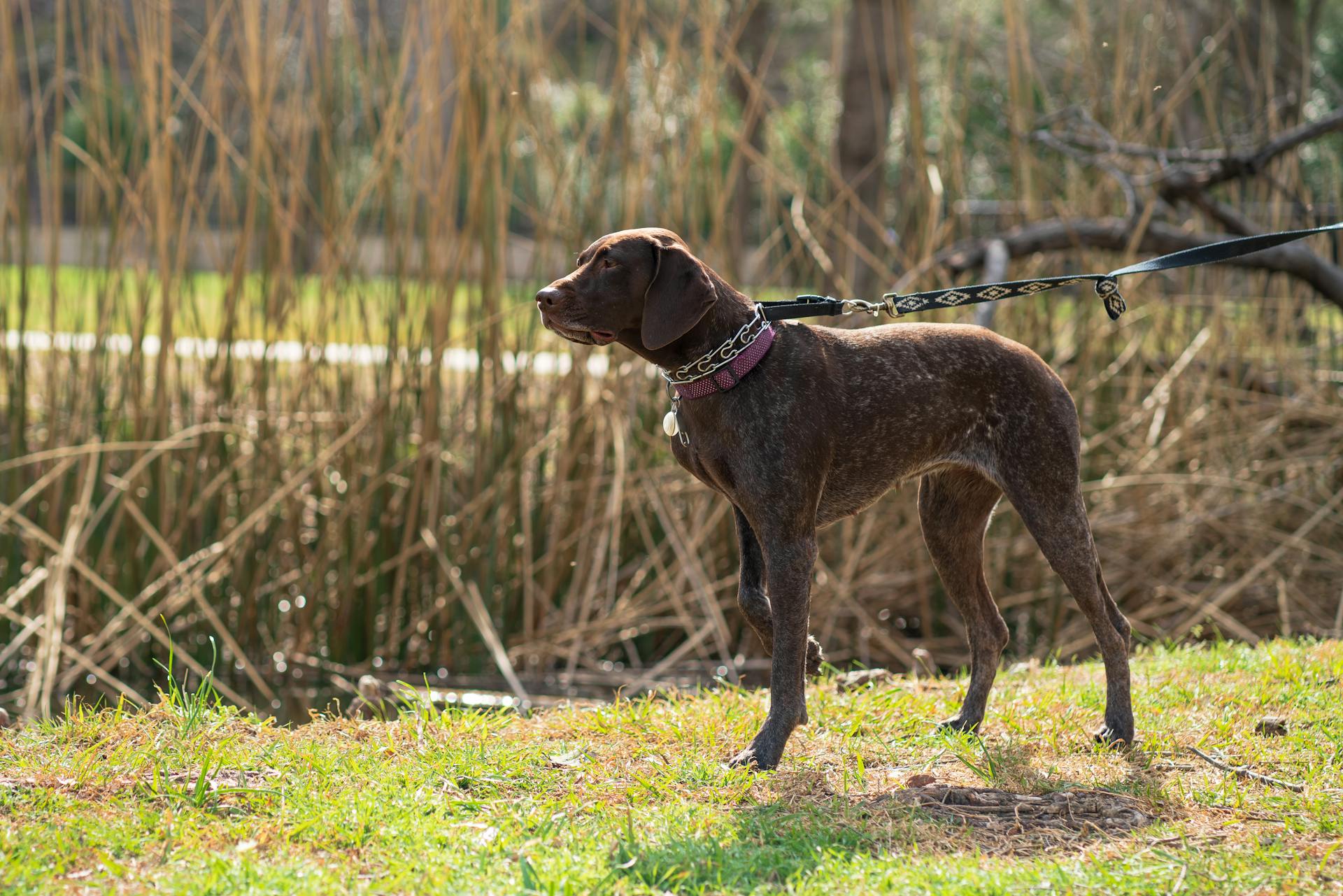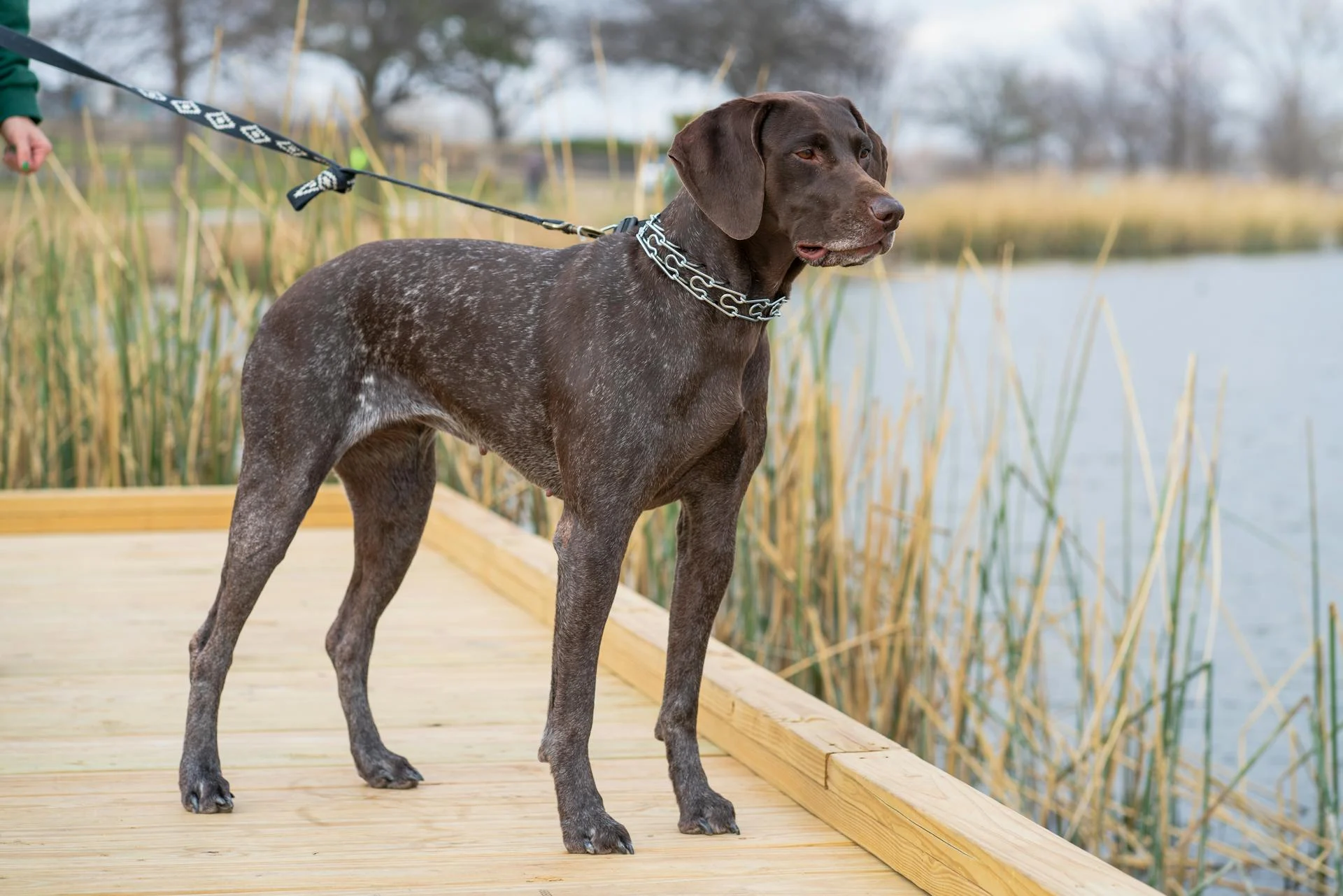
The German Shorthaired Pointer is a beloved breed known for its versatility and friendly nature. On average, a German Shorthaired Pointer's lifespan is around 12-14 years.
These dogs are generally a healthy breed, but like all breeds, they can be prone to certain health issues. Hip dysplasia is a common problem in German Shorthaired Pointers, which can lead to arthritis and mobility issues.
Regular exercise and a balanced diet can help prevent or manage hip dysplasia in German Shorthaired Pointers. With proper care, many of these dogs can live long, healthy lives.
Health and Care
German Shorthaired Pointers are generally a healthy breed, but like all dogs, they can be prone to certain health conditions. Hip dysplasia is a condition in which the hip joint does not develop properly, and it's essential to have your GSP tested for this condition to prevent severe cases.
Regular exercise is crucial for GSPs, as they thrive on physical activity and can become nervous and destructive if they don't get enough. A minimum of an hour of exercise per day is recommended, including strenuous hikes, long walks, and energetic games of fetch.
Check this out: How Much Exercise Do Labrador Retrievers Need
To prevent health issues, it's essential to keep your GSP's weight in check, as obesity can exacerbate conditions like hip dysplasia and GDV. A balanced diet and regular vet check-ups can help ensure your GSP stays healthy.
Here are some common health issues that can affect GSPs:
- Hip and elbow dysplasia
- Epilepsy
- Cancer (including canine hemangiosarcoma)
- Addison’s disease
- Progressive retinal atrophy
- Lyme disease
By being aware of these potential health issues and taking preventative measures, you can help ensure your GSP lives a long and healthy life.
Health Issues
German Shorthaired Pointers are generally a healthy breed, but like all dogs, they can be prone to certain health conditions.
Hip dysplasia is a common issue in GSPs, where the hip joint doesn't develop properly, causing pain and potentially requiring surgery.
Proper diet and exercise can help manage mild cases of hip dysplasia, but severe cases may necessitate surgical intervention.
Cancer is another health concern for GSPs, with a higher incidence of certain types, such as mammary tumors, mast cell tumors, and lymphosarcoma.

Regular veterinary check-ups and preventative measures can help detect cancer early on.
Von Willebrand's disease is a blood disorder that affects the clotting process, causing symptoms like nosebleeds, bleeding gums, and prolonged bleeding after surgery.
This condition can be managed with appropriate treatments, but it cannot be cured.
Gastric dilatation-volvulus (GDV), also known as bloat or torsion, is a life-threatening condition that can occur in deep-chested breeds like GSPs.
Factors that can contribute to GDV include eating one large meal a day, eating rapidly, and exercising vigorously after meals.
Elevated feeding dishes and specific types of food may also play a role in GDV.
To prevent GDV, it's essential to feed your GSP multiple smaller meals throughout the day and avoid exercising them vigorously after meals.
Here are some common health issues that can affect GSPs:
- Hip and elbow dysplasia
- Epilepsy
- Cancer
- Addison's disease
- Progressive retinal atrophy
- Lyme disease
Make sure to consult with your veterinarian about performing preventative tests for cancer and Lyme disease, especially if your GSP has a history of these conditions in their family.
Care

German Shorthaired Pointers require regular exercise to stay happy and healthy. At least an hour of physical activity per day is essential to prevent nervousness and destructive behaviors.
Their high energy levels and endurance make them perfect for active families who have a spacious yard with a secure, high fence.
GSPs love strenuous hikes, long walks, and energetic games of fetch, so be prepared to get moving with your furry friend.
To prevent mischief, crate your young GSP when you're not supervising, especially in areas where they might get into trouble.
Training your GSP requires kindness, consistency, and positive reinforcement methods like food rewards and praise.
Short training sessions and a focus on positive outcomes will keep your GSP engaged and eager to learn.
With proper care and attention, your GSP can thrive and become a loyal and loving companion for years to come.
Their short coats require minimal grooming, but they do shed moderately, so be prepared for some extra dog hair.
On average, GSPs live for 10-12 years, making them a long-term companion for many families.
A unique perspective: German Wirehaired Pointer Short Hair
Grooming
Grooming your German Shorthaired Pointer (GSP) is a relatively low-maintenance task, requiring only a quick wipe with a grooming mitt.
The GSP's short coat sheds heavily, with small hairs covering furniture, floors, and clothes.
Regular nail trimming is essential, as is checking and cleaning the ears to prevent infections.
An occasional bath may be necessary, especially if your dog has a knack for finding smelly things to roll in.
Brushing your GSP's teeth regularly will help keep their breath fresh and their teeth healthy.
Related reading: English Setter Grooming
Diet and Nutrition
A German Shorthaired Pointer's diet is crucial to their overall health and longevity. To determine the right amount of food for your GSP, consider their size, age, build, metabolism, and activity level - a highly active GSP will naturally require more food than a less active one.
It's essential to choose high-quality dog food that provides better nutrition, allowing you to feed smaller portions while meeting their nutritional requirements. Higher-quality dog food can make a big difference in your GSP's health and well-being.
A recommended daily amount for a GSP is 2 to 3 cups of high-quality dry food, divided into two meals. However, this can vary depending on your dog's individual needs, so it's crucial to monitor their weight and adjust their food intake accordingly.
If your GSP is overweight, you can perform the eye test and hands-on test to determine if they need to lose weight. To maintain your GSP in good shape, it's recommended to measure their food and offer it in two meals per day rather than free-feeding throughout the day.
German Shorthaired Pointers can become obese if they don't engage in extensive physical activity, so it's vital to avoid overfeeding them to maintain proper body conditioning and weight. This breed thrives on regular exercise and a balanced diet.
To maintain your GSP's joint health, consider adding nutritional supplements with glucosamine and chondroitin, especially if they have hip or elbow dysplasia. Omega-3 supplements can also aid in protecting joint health and keeping their skin and coat healthy.
A quality, high-protein dog food is essential for your GSP's nutritional needs, and it's recommended to talk with your veterinarian to create a portion plan suitable for your dog's age, weight, and activity level.
Explore further: Why Are Labradors so Popular
General Information
The German Shorthaired Pointer is a medium to large-sized breed of dog. They typically weigh between 45-65 pounds and stand between 21-25 inches tall at the shoulder.
Their short coats require minimal grooming, making them a great choice for busy owners.
On average, German Shorthaired Pointers live for around 12-14 years with proper care and attention.
History
The German Shorthaired Pointer has a rich history dating back to the 17th century, but the breed we know today was specifically developed in the mid- to late 19th century to be a versatile hunting dog.
Prince Albrecht zu Solms-Braunfeld of the Royal House of Hanover played a significant role in encouraging breeders to prioritize function over form when selecting early specimens, resulting in a lean, athletic, and responsive hunting dog.
The first German Shorthair arrived in the United States in 1925, imported by Dr. Charles Thornton of Montana, who went on to breed them.

By 1930, the GSP had attained AKC recognition, and by the 1950s, the breed experienced significant advancements in the US.
Many consider 1968 as the peak year for German Shorthaired Pointers in the US, with three out of the top four finishers at the AKC National Field Trial Championship having already achieved their conformation championships.
The breed's popularity continues into modern times, making the AKC's top 10 list for the most popular dog breeds.
The German Shorthaired Pointer's name is a clear giveaway to its country of origin, Germany, where it was developed in the 1800s as a gun dog that could hunt game and retrieve birds equally well.
The breed's friendly, trainable personality makes it a capable partner but also an easy companion, which is likely why it's a popular choice for sportsmen and active families.
The first German shorthaired pointers were brought to the United States in the late 1920s, and by the spring of 1930, the GSP had attained AKC recognition.
The breed's versatility and athleticism have made it a favorite among hunters and dog enthusiasts alike, with its love of swimming and retrieving making it a dream dog for waterfowl hunters.
Personality

The German Shorthaired Pointer is known for its intelligence. They approach everything with enthusiasm, displaying a confident and steady demeanor without being nervous or flighty.
This breed forms strong bonds with everyone in the family, but they may have a special favorite member. They do not enjoy being left alone and can develop separation anxiety.
German Shorthaired Pointers are highly trainable and enjoy the mental stimulation that training provides. They are receptive to learning and can thrive as house dogs.
Early socialization is crucial for GSPs, as it exposes them to a wide range of people, sights, sounds, and experiences. Enrolling your GSP puppy in a puppy kindergarten class is an excellent way to kick-start their socialization journey.
Choosing a puppy with a nice temperament is essential, characterized by curiosity, playfulness, and a willingness to approach and interact with people. Opt for a middle-of-the-road puppy rather than one who displays excessive aggression towards littermates or one who is overly timid and fearful.
About

I'm glad you're interested in learning more about the topic. Here's the scoop: this information is all about the basics, covering the fundamentals of the subject matter.
The purpose of this overview is to provide a broad understanding of the topic, highlighting its key aspects and characteristics.
You can find a wealth of information on the topic by exploring the various sections of this article, which delve into specific areas of interest.
One of the most important things to note is that the topic has a rich history, with roots dating back to ancient times.
Sources
- https://dogtime.com/dog-breeds/german-shorthaired-pointer
- https://www.dogbreedinfo.com/germanshorthairedpointer.htm
- https://www.petmd.com/dog/breeds/german-shorthaired-pointer
- https://www.petguide.com/breeds/dog/german-shorthaired-pointer
- https://www.thesprucepets.com/german-shorthaired-pointer-dog-breed-profile-4777640
Featured Images: pexels.com


